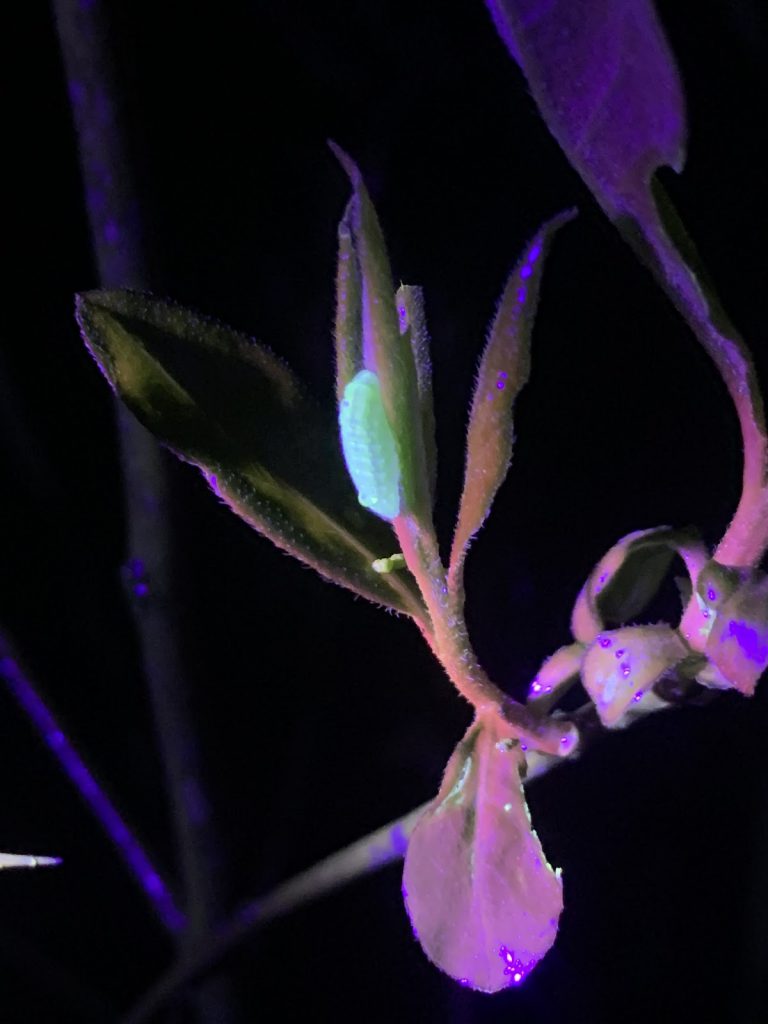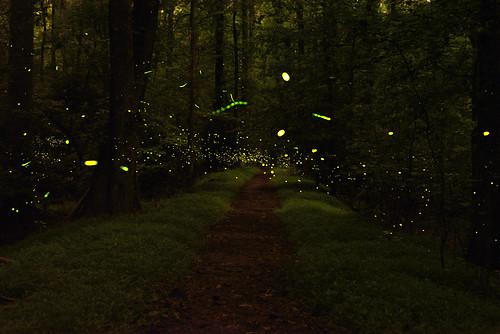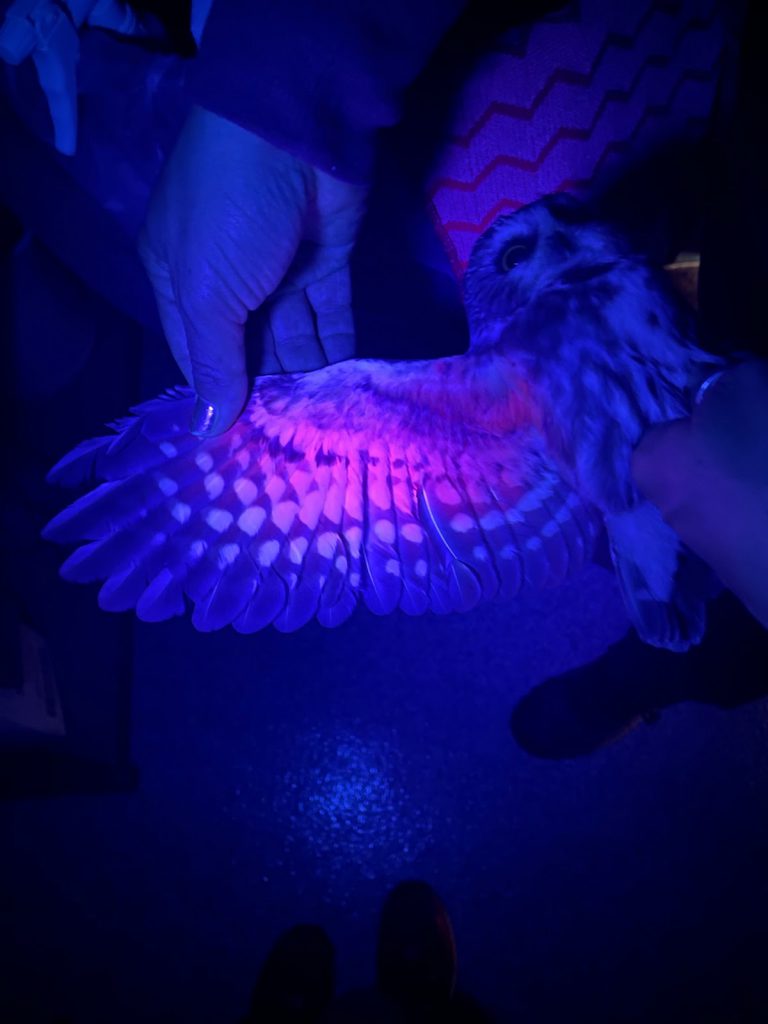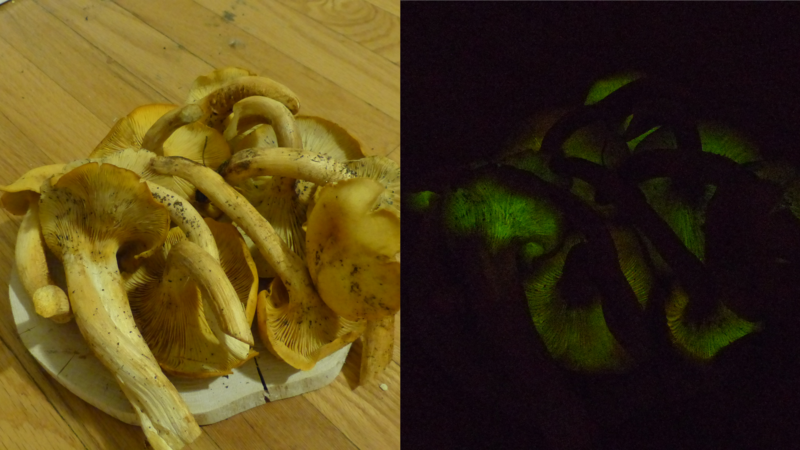
King’s hairstreak biofluorescence, by Jen Selfridge
As winter approaches, many of us dread the shortening hours of daylight and increasing darkness. In this spookiest of seasons, I like to focus on ways to appreciate the nighttime and the bits of unexpected light hidden in the natural world. Plenty of living things have unique ways to glow in the dark!
Bioluminescence and biofluorescence are two phenomena that many people may never notice, with an ecological purpose that fascinates and still occasionally mystifies scientists. Bioluminescence is a biochemical process of emitting light used by living organisms; think- algae, glow worms, and fireflies! Biofluorescence, on the other hand, is the absorption and re-emitting of light from the sun. Often, this light is emitted in a spectrum we can’t see, so it requires the use of special lighting or filters to see. The most famous animal examples of this are likely Australia’s platypus and wombat, numerous tropical bird species, and desert scorpions.
Exotic locales don’t get to have all the fun when it comes to glowing creatures! Extended nighttime hours mean extra opportunities to get outside and search for bioluminescence and fluorescence in your own yards and communities. Here are a few of Maryland’s luminous living things, and some ideas for how to protect them.

Greenbelt Park Fireflies by Jeffrey Walters
Insects: Numerous species of bioluminescent firefly (not a fly, but a beetle!) light up Maryland’s summer nights, using an organ in their abdomen to combine oxygen and luciferin to produce a heatless light. Patterns of light flashing help this insect communicate with potential mates, and may even warn predators of their distastefulness. Firefly populations are declining due to development and light pollution; you can help by turning off outdoor lights at night! With a more subtle biofluorescence, King’s hairstreak caterpillars (an endangered species in Maryland) and monarch butterfly caterpillars both display stunning brightness under UV light. Plant host plants to support monarchs and other local pollinators, and make sure to leave some dead material for fall!
Aquatic Creatures: Dinoflagellates and some species of jellyfish are just a few of the ocean creatures that exhibit bioluminescence. Every so often, lucky Marylanders are treated to an ocean glow show as these simple, beautiful creatures produce light in the waves. See how the Department of Natural Resources is working to protect oceans, here!
Flying Squirrels: As if flying squirrels weren’t already cute enough, they also glow pink in the right conditions under ultraviolet light. This phenomenon was only very recently discovered, and scientists are still puzzling out a conclusive explanation for it. Want to support Maryland squirrels? Check out this page for more!
 Owls: The use of ultraviolet (black) light causes a pigment called porphyrin to fluoresce in owl feathers; those from younger birds glow a brighter shade of pink than older adults that have been through additional molting cycles. This fact has helped ornithologists determine the age of birds they study, especially in barn owls and northern saw-whet owls.
Owls: The use of ultraviolet (black) light causes a pigment called porphyrin to fluoresce in owl feathers; those from younger birds glow a brighter shade of pink than older adults that have been through additional molting cycles. This fact has helped ornithologists determine the age of birds they study, especially in barn owls and northern saw-whet owls.Foxfire: The term “foxfire” generally refers to bioluminescence created by certain species of fungi. In Maryland, two well-known glowers are the jack-o-lantern mushroom (Omphalotus olearius) and the bitter oyster (Panellus stipticus). Found on rotting wood, the glow is emitted by healthy fungal cells using a similar mechanism as fireflies with oxygen and luciferin. This is an important survival strategy for the fungi, attracting insects to spread spores to new food sources.

Jack o’ Lantern mushrooms bioluminescence by KeithMiklas (cc-by-2.0)
Bacteria: Glowing things come in tiny packages too! The Photorhabdus luminescens bacteria is a lethal pathogen of insects, but also has a cool legend associated with its possible presence on a Civil War battlefield. Check out more details here.
References
https://education.nationalgeographic.org/resource/bioluminescence
https://museumsvictoria.com.au/arti...standing-bioluminescence-and-biofluorescence/
https://mpt.pbslearningmedia.org/re...creatures-of-light-how-biofluorescence-works/
Welcome back to HabiChat!
With winter on the way, we turn to topics that inspire us in this spooky season of decreasing daylight. In this issue, I’m happy to share an introduction to glow-in-the-dark living creatures, a phenomenon that has always been one of my favorite marvels of the natural world. DNR’s resident bat expert, Dana Limpert, collaborates on a native animal feature about our favorite flying mammals. Plus, Outreach and Education Assistant Edwin Guevara describes some entertaining and educational outdoor activities for these dark evenings and we suggest some Natural Areas to visit in this perfect season for hiking.
Happy fall!
Sarah Witcher
Sarah.Witcher1@maryland.gov
Click here to have HabiChat—the quarterly backyard wildlife habitat newsletter from the Wild Acres program—delivered right to your inbox!
In this Issue
Natural Heritage Program Spotlight: Fall Swamps
Native Animal Profile: Our BFFs, Bats
Get Outside at Night: Experimenting with Light

